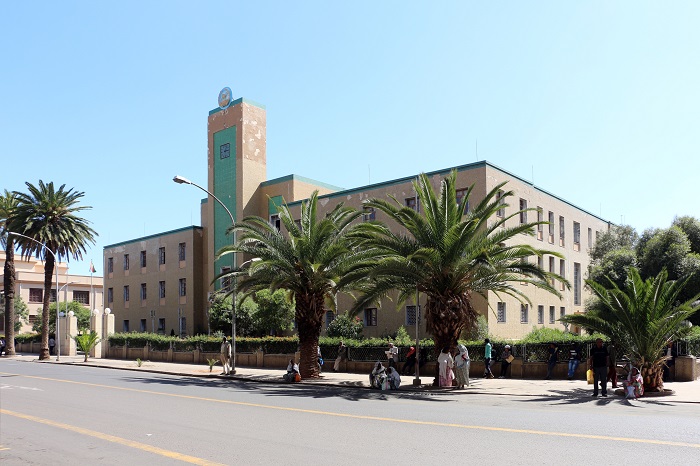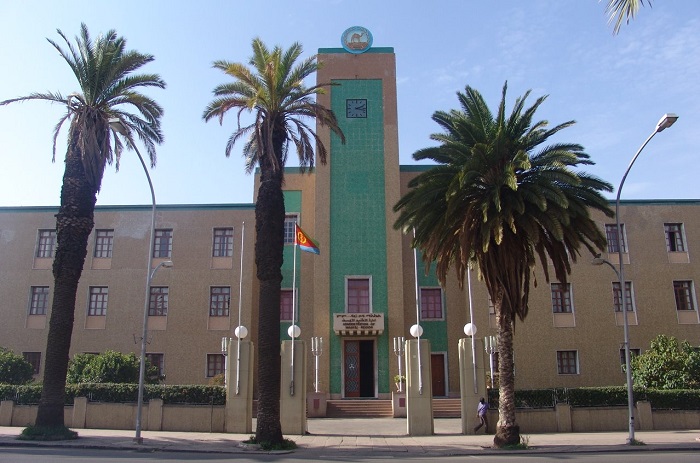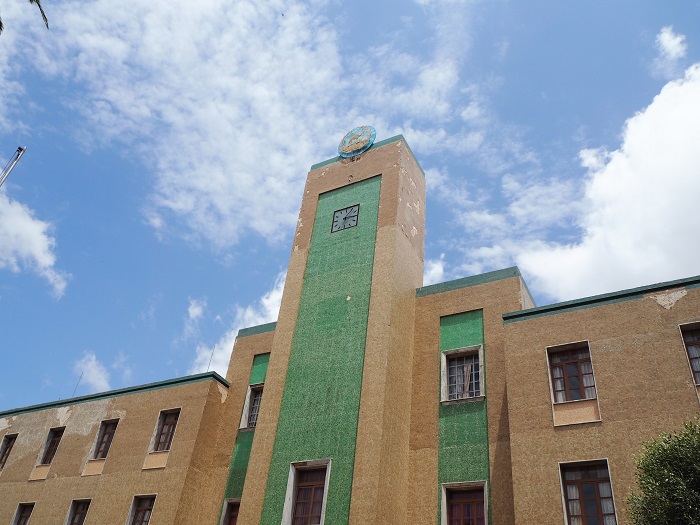The Governor’s Palace of Asmara, also referred to as the City Hall of Asmara, is a historic building that serves today as the official city hall of the city of Asmara, and it is located on Harnet Avenue in the heart of the city, which is the capital city of the State of Eritrea. As this prominent landmark embodies the city’s colonial history and architectural splendor, it was built in an Italian Art Deco style during the time when Italy was ruling this part of Africa. Situated in one of the most accessible and central streets of the city, the palace has a surrounding of other modern and also historically important buildings, making it a key point of reference for locals and visitors. The location where it is centered reflects the administrative and political significance Asmara held during the Italian colonial period, as it provided a symbolic and practical prominence with its central position in the city. The palace’s visibility and accessibility make it an important feature of Asmara’s cityscape, drawing attention to the architectural and cultural achievements of the early 20th century.
The Governor’s Palace had a predecessor, which was built in 1897; however, the structure we are seeing today was constructed in the 1930s, during the period when Eritrea was an Italian colony. The intended purpose of the building was to serve as the residence and also as an administrative center of the Governor who would rule the African colony. This position represented the highest level of authority within the colony, hence why the building was intended to be built in a grandiose style, more precisely in a Fascist architectural style, in Italian called Littorio. The building’s construction was intended to project power, stability, and modernity, signaling the Italian presence and influence in the region. The central location in a highly visible part of Asmara strengthened the palace’s role as a symbol of colonial governance and oversight, further allowing the colonial authorities to continue their maintenance of the proximity to other key government offices, military installations, and the growing commercial hub of the city.
As mentioned above, the architectural style of the Governor’s Palace follows the grandiose Fascist architectural style, although it is generally classified as Italian Rationalism. This style gained prominence in Italy during the interwar period and was characterized by symmetry, geometric clarity, and a sense of monumental simplicity. The overall design was created to convey authority and order, while at the same time, it incorporated modern construction techniques of the time. The palace’s exterior features one central tower distinguished by its color, which is given by the vibrant teal or light green tiles, which contrast sharply with the rest of the façade. Near the top of the tower is a circular clock face, and above that, a small, lighter-colored circular crest with an emblem of the country.
ADVERTISEMENT
This central tower is flanked symmetrically by two large, multi-story wings, while the building has clean lines, expansive façades, and large windows that allow natural light to illuminate the interior. The building was built from locally sourced materials, as well as some imported ones, and this included reinforced concrete, stone, and stucco, which was deliberate, thus ensuring the durability and the equally striking visual aesthetic that aligned with European architectural ideals while adapting to the Eritrean environment. The reason why this architectural style was used was not because it was so popular during the 1930s, but because the Italian colonial administration had the desire to project a sense of rational order and control, as they combined aesthetic modernity with political symbolism.
Once it was completed, the Governor’s Palace quickly became a central hub for political and administrative activity, and the overall structure represented a significant stamp on Eritrea at that time because it was seen as a statement that served as a functional residence and office. It also had a clear statement of the Italian colonial agenda in East Africa and the plans Italy had for this African region. Throughout its initial years, the palace hosted official ceremonies, governmental meetings, and receptions for visiting dignitaries, which clearly made a statement about a main structure where governance and diplomacy were performed.
Throughout the decades, as the authorities changed, the palace did not change at all, and it preserved its look, and today, the Governor’s Palace continues to hold cultural and historical importance. While it no longer functions as the primary residence of a colonial governor, the building remains a vital administrative site. From time to time, it is used for official state functions and ceremonial events, which is why its preservation and ongoing use demonstrate Eritrea’s recognition of the palace as a key historical and architectural landmark. Serving as a tangible link to Asmara’s past, today the Governor’s Palace reflects the city’s unique colonial heritage, while telling the story of how an architectural masterpiece can shape civic identity. Sadly, visitors can only see the palace from the outside, appreciating the symmetry and monumental design that has endured for nearly a century.
If you would like to see this amazing building in central Asmara, it is relatively straightforward, as Harnet Avenue is well-connected to other parts of Asmara. You can either approach the palace on foot or by vehicle, but if you decide to have a tourist guide or perhaps talk to some locals, you are certain to learn more about the history behind this palace. While the interior is not always open to the general public due to its administrative use, just seeing the palace on the outside is enough for you to get inspired and to tell the story about Eritrea’s colonial past, thus giving you ample opportunities for photography, observation, and appreciation of its architectural features. While you are standing in front of the Governor’s Palace, you can see other significant buildings nearby, and these include the central market, colonial-era residences, and public squares, creating a comprehensive view of Asmara’s historical landscape.

There have been a lot of significant historical developments, including the transition from Italian colonial rule to British administration following World War II and, later, the establishment of an independent Eritrean state. Each of these periods left its mark on the building, and this was either through functional modifications or subtle architectural adjustments, but it is interesting that the building was still kept in the original form while reflecting the layered history of governance and society in Eritrea. Even with ongoing maintenance and prominence in public life, the building demonstrates the immense value it has, and this is mostly placed on preserving the historic story behind it while adapting it to contemporary uses.
In conclusion, this is not a historical beacon, but rather a symbol of Asmara’s colonial past, architectural ingenuity, and enduring administrative relevance. With the strategic location on Harnet Avenue, Italian Rationalist and Fascist design, and historical significance, it is considered one of the most unique architectural pieces on the African continent. If you are captivated by the combination of architecture, history, and urban development, then it is certain that you will enjoy this simple yet very amazing building. The Governor’s Palace’s ability to connect the past and the present, while combining aesthetic appeal with ongoing civic function, leaves its mark on Asmara’s identity as a former colony that is today governed by the Eritreans. If you were visiting this small country in the Horn of Africa, the Governor’s Palace will certainly offer you a visual and educational experience, while further providing insight into the forces that shaped one of Africa’s most unique and architecturally rich capitals.





